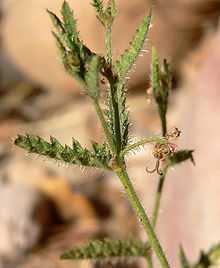Tragia
From Wikipedia, the free encyclopedia
| Tragia | |
|---|---|
 | |
| Tragia ramosa, southern Nevada | |
| Scientific classification | |
| Kingdom: | Plantae |
| (unranked): | Angiosperms |
| (unranked): | Eudicots |
| (unranked): | Rosids |
| Order: | Malpighiales |
| Family: | Euphorbiaceae |
| Subfamily: | Acalyphoideae |
| Tribe: | Plukenetieae |
| Subtribe: | Tragiinae |
| Genus: | Tragia L. |
| Species | |
|
About 100, see text | |
| Synonyms | |
Tragia is a genus of flowering plants in the spurge family, Euphorbiaceae. It comprises about one hundred species found in tropical and subtropical regions worldwide. Plants in this genus are sometimes known as noseburns.[1]
These species are used in Siddha medicine, which is practiced by the Tamil people. Kaanchori (Tamil: காஞ்சொறி), as it is known to them, is used in curing eczema, fevers, wheezing, and diabetes.
Selected species
- Tragia adenanthera
- Tragia affinis
- Tragia balfouriana J.B.Gillett (Yemen)
- Tragia bicolor
- Tragia cannabina
- Tragia cissoides
- Tragia cordata Michx. – Heartleaf Noseburn
- Tragia hispida Willd.
- Tragia involucrata climbing nettle |
- Tragia laciniata (Torr.) Muell.-Arg. – Sonoita Noseburn
- Tragia nepetifolia Cav. – Catnip Noseburn
- Tragia ramosa Torr. – Branched Noseburn
- Tragia saxicola Small – Florida Keys Noseburn
- Tragia volubilis – Creeping Cowitch, Fireman[1]
References
- ↑ 1.0 1.1 "Tragia". Integrated Taxonomic Information System. Retrieved 31 March 2010.
External links
![]() Media related to Tragia at Wikimedia Commons
Media related to Tragia at Wikimedia Commons
![]() Data related to Tragia at Wikispecies
Data related to Tragia at Wikispecies
This article is issued from Wikipedia. The text is available under the Creative Commons Attribution/Share Alike; additional terms may apply for the media files.